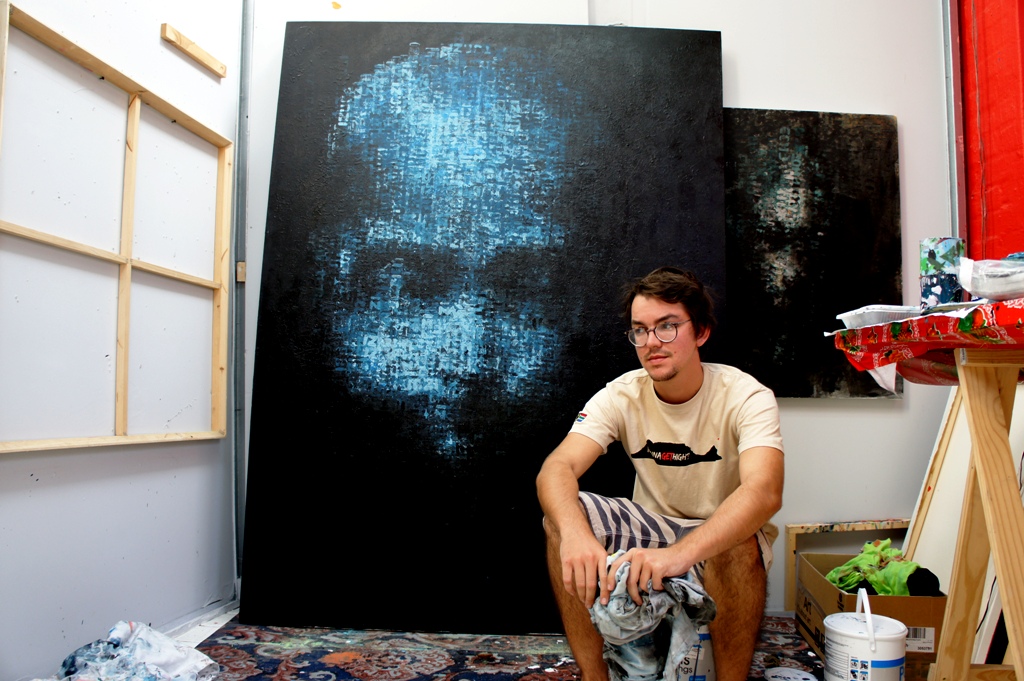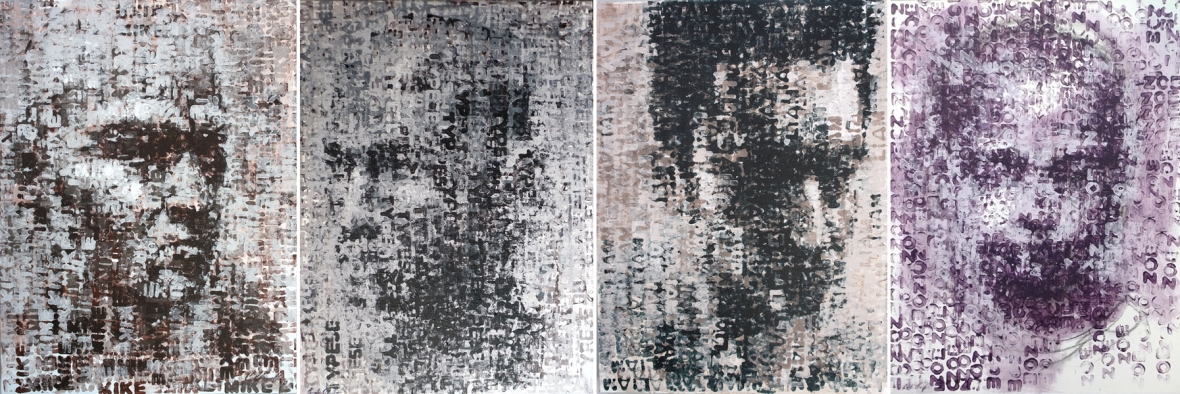chandlerstudio.weebly.com

A: How old do you feel?
CC: 9125 days old
A: Tell us something about yourself in one sentence?
CC: I bark and howl when I’m happy or excited.
A: When did you decide to take up painting?
CC: At 16 I knew that I wanted to be an artist.
A: What do you aim to capture in your work?
CC: With my current series ‘Binary Visage’ I try create a strong marriage of Realism and Abstraction.
A: Do you have a favourite work or muse?
CC: Currently I’m really inspired by Andrew Salgado’s work. Also I only like painting with either hip-hop or trip-hop music playing.
A: Portraiture is a strong theme in your work? Why the draw towards people?
CC: Portraiture is the cornerstone of my creative journey. I started my art career with portraiture in 2005. It enabled me to grow and branch out as an artist over the years. It is my concrete as a young artist. The subject keeps me focused, motivated and confident. Portraiture has also given me the skills needed to pursue other fields of art with technical confidence. Portraiture has also had a predominant role throughout the history and evolution or art. For me it’s great to play with that fundamental foundation and interpret it with modern dialogue.
A: In your series, Binary Visage, you created the form through text. Can you tell us about this series? Why text specifically?
CC: Trained as a realist painter I soon found myself at a dead-end. My creative dialogue felt muted as there was no sense of interpretation or transformation with my subject matter as they became mere copies. I discovered Chuck Close in my first year of studies. I fell in love with the marriage of Impressionism/pointillism with Super Realism. This relationship created a new dialogue with the viewer and the subject. Up close a sense of intimacy is established as web of patterns and forms emerge creating a new channel for communication. Which viewed from a distance a single or unified image is visible.
In a world now moulded by social and online media, everything has become digitized. In its primal core all internet information and imagery is nothing more than 1s and 0s (binary code), this transformation factors to the basis for my body of work. As a child I was fascinated with computers, especially the ability to ‘Hack’. To me this meant that a world could be manipulated and transformed with creativity… Hackers challenge and change the system to make them work differently to make them work differently, to make them better. A ‘Hacker’ then could actually be applied to any field… I describe myself as a ‘Portrait Hacker’.
My process is to modernize the traditional portrait by mechanically etching it into text. The digitized rendition transforms and re-invents the subject. When constructing the portrait the conventional process of paint brush to canvas is eliminated. I make a stamp by using foam letter cut outs. I assemble a name or word which has a connection with my subject. I continuously stamp and layer the print, working almost ‘blind’ but mindful of structure and tonal values. The process might seem very mechanical, however the formation of the image is very organic as I cannot dictate exactly how the stamps form the portrait… The image finally emerges: transformed in a coded and industrialized web of paint.
A: Many Fine Arts students feel that after they graduate, there is no work in Fine Arts anymore, and only established artists will make it. How has it been to remain pure to painting and do you have advice for artists who want to continue creating after they graduate?
CC: Anyone wanting to become a fine artist must realise that you in for a really tough ride. You must have a hunger for it… which means that you must eat, breathe and shit art. It’s very unrealistic and rare for fine art students to immediately make a living solely from their art just after graduating.
During my studies I was already trying to get my work into every gallery and exhibition. I was also working part-time for sculptors, galleries and anyone involved in the art scene, It’s important to plant many seeds in the art community. The more you learn about the strategies and structure of the art market the easier it will be to engage and infiltrate it. Networking is so important!
After graduating I moved to Cape Town. I was working for an art retailer, I was teaching private art lessons to children and I was a hang man (hanging art in people’s homes.). In the evenings I was painting in a small space at my flat, selling paintings now and then. I did this for nearly 2 years, just getting by each month and eventually after all the networking and patience I got an opportunity to make a lot of money producing works for a huge corporate function. With that money I quit my retail job, I could pay 4 months studio rent and flat rent… and that’s exactly what I did. In those 4 months I painted nearly every day and approached many galleries. Now I’m a full time artist, and I have 6 galleries representing me.
As a painter/artist its important to create an identity with your work. The ‘Binary Visage’ series worked in my favour as it’s unique. People like buying art they know… So the more work you get out there with a consistent technique or style the better chance you have of a client remembering you. This makes it tough for young realist artists as you will have so much competition and you will disappear into the crowds.
It’s also helps getting a commercial gallery to represent you. If the gallery believes in you they often will help guide, promote and grow you.
So my advice then for young artists leaving art school is find work that has some connection to the art scene (galleries, art retail, artists, framing, teaching ect.) and at the same time keep producing art work. If possible take part in as many group shows and enter every art competition. With a lot of hard work, networking, patience and luck that opportunity to make a giant leap in your career will happen.
A: How did you get involved with Studio41 and are there many artists involved in this collective?
CC: I got invited to take part in a group exhibition at Studio 41 in 2013. I instantly feel in love with the space. There are about 9 studios and an exhibition area. So when I quit my job I moved into the studio and have never looked back. Currently there are 5 painters, a ceramicist, photographer, and a fashion designer, they are my second family. We also rent out the space for private and public functions. We try host an exhibition every 2 months.
A:How does space impact your work?
CC:Well in terms of my working environment i really love painting with other artists. Otherwise it can be a very lonely career. It’s important to always have an extra pair of eyes as you can get lost in your work. It’s great to get advice and feedback, this helps with confidence or direction.
I’m a manic painter so I need tons of space to run around.
A: Where are you based and can anyone commission you to do a portrait?
CC: I’m based in Cape Town. My studio is located at Studio 41. I’ve done a number of private commissions for clients. Anyone interested can contact me through my website or email (claudechandler@hotmail.com)
A: Who has been your inspiration throughout your career?
CC: My Mother. She trained me as a painter and artist, my fine art skills are all thanks to her. I think she is one of South Africa’s best painters and I am very blessed to have her as a mentor.
A: Any favourite local musician’s?
CC: Fruit and Veg, Die Antwoord
A: Ever considered space travel?
CC: Well considering what I was getting up to in Art School, Think I was space travelling.
A: Fridays or Sundays?
CC: Sunday man
A: Where would we find you on a rainy day?
CC: Monday – Friday at my studio, Saturday and Sunday, somewhere cosy.
A: Complete the sentence: I never thought… ?
CC: I would be at this stage in my career at such a young age.


